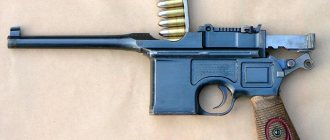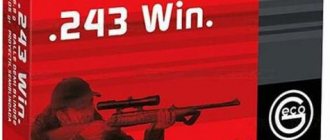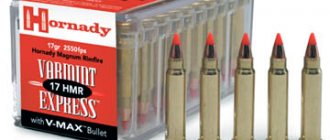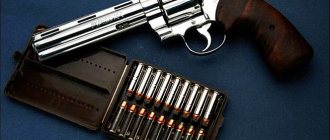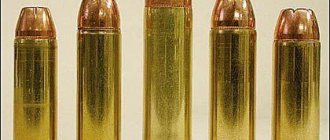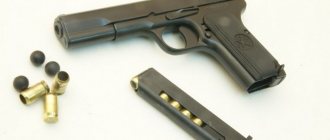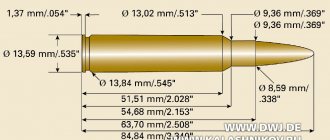Story
Among others, Research Armament Industries from the USA took on the creation. Using the .416 Rigby hunting cartridge as a basis, designers Boots Obermeyer and Jim Bell (who would later create the .700 Nitro Express, which became the most powerful hunting cartridge) create a cartridge that meets the requirements of the competition. It gets the name .338 Bell. But despite the formal compliance with the conditions, there is a significant drawback. The .416 Rigby case could not withstand the strong pressure of the powder gases and was severely deformed, which not only led to rapid wear of the weapon, but could also be dangerous for the shooter.
After the first failures
The palm went to Lapua from Finland. They created an original sleeve, which solved the problem of deformation. The cartridge has a bottle-shaped case, the rim does not protrude. The maximum pressure of gunpowder during an explosion was 400 MPa, and the cartridge case withstood a pressure of 420 MPa. Then they developed another bullet, more suitable for shooting at a person at such a long distance. Four years later, in 1987, the company begins producing 338 caliber (8.6 x 70 mm) under the Lapua Magnum label.
8.59mm Titan
(Lazzeroni) developed the 8.59 mm (.338) Titan cartridge in 1994. It is created on the basis of a very large cartridge case (which is typical for all Lazeroni cartridges), bottle-shaped, without a rim, with a slope of 30 degrees. The diameter of the bottom of the sleeve is 14.7 mm, the length of the sleeve is 7.11 cm, and the total length of the cartridge is 9.52 cm.
The rather unusual metric designation for the caliber of Lazeroni rifles and cartridges is explained by the fact that the caliber is measured by rifling, and not by margin, as is customary in most European countries.
Thus, the usual .300 caliber becomes 7.82 mm, and .338 becomes 8.59 mm. Regardless of nomenclature, the Titan cartridge uses the same .338 caliber bullets as the other .338 super magnum cartridges mentioned in this article.
produces cartridges equipped with bullets weighing 185, 200, 225 and 250 grains. The initial flight speed of the A-Frame bullet weighing 250 grains is 930 m/s, the muzzle energy is 790 kgf m.
At a distance of 360 meters, the bullet's flight speed will be 714 m/s, the muzzle energy will be equal to 465 kgf m. When zeroing a rifle at a distance of 270 meters, the excess of the bullet's flight path above the aiming line at a distance of 90 meters will be 8.4 cm, at a distance of 180 meters - 10.16 cm, at a distance of 360 meters the bullet’s flight path will be 23.6 cm below the aiming line.
Officials claim that the bullet has a higher flight speed and the bullet's flight path is more flat.
At the same time, they deliberately ignore the fact that the shooting was carried out at an altitude of 900 meters above sea level, and not at the traditionally accepted altitude of 300 meters. Naturally, at higher altitudes the resistance force of rarefied air is less.
In addition, only on Ladzeroni rifles the line of sight is 5.08 cm (usually this value is 3.8 cm) above the bore, which gives company representatives the opportunity to extol the flatness of the bullet’s flight path.
Titan cartridges are specifically designed for hunting big game at long ranges. To realize the potential inherent in the cartridge, it produces rifles chambered for .338 caliber exclusively with barrels 68.6 cm long.
To be fair, it should be noted that rifles and cartridges are considered very expensive even in their class of weapons and, like any exclusive product, are produced in limited quantities.
The Silent Killer
In parallel with the creation of the cartridge, Accuracy International LTD from England was developing a rifle for caliber 338, the purpose of which was accurate shooting at vast distances in extreme conditions (low temperatures, strong winds). The so-called Arctic sniper rifle, nicknamed the “silent killer”. We now know it under the names Arctic Warfare Magnum, L115A, and L96. When shooting from one kilometer, the rifle had a spread of 15-16 cm, this is a very accurate indicator. For example, a rifle chambered in .50 Browning had a dispersion of about a meter under the same conditions, given the greater recoil, weight and much louder shot.
An Arctic rifle set a record that has not yet been broken by anyone: two people were killed with two shots at a distance of about two and a half kilometers. The Arctic Warfare Magnum rifle comes in two more calibers: 6.2 and 7.62. Its weight with an empty magazine can vary depending on the modification from 6.1 to 7.3 kg.
BULLETS:
The shooting accuracy of Lapua bullets is based on their exceptionally high quality. The production process is precisely calibrated to ensure consistent quality. The best raw materials, careful manufacturing and quality control at every stage of production. Constant monitoring of the technological process is carried out using various measurements, checks and test firings.
SCENAR - have the best performance for competitive shooting
The Scenar is a highly accurate HPBT (Hollow Point Boat Tail) bullet with outstanding ballistic coefficients in any caliber. In addition, there are silver-plated Scenar Silver Jacket bullets, which reduce friction in the bore. Available in .223 REM MATCH calibers. 6mm BR Norma, 6.5x55 Swedish, .308 WIN and .338 Lapua Magnum.
D46 is their motto: “Often copied, never duplicated.”
The legendary D46 won its first gold medal in 1935 and remains one of the most accurate FMJBT (Full Metal Jacket Boat Tail) bullets. The D46 is chambered in .308 Winchester.
Lock Base - unsurpassed shooting accuracy at ultra-long distances
Lock Base bullets are designed for ultra-long range shooting. The patented structure of the bullet tail ensures exceptional shooting accuracy even at increased powder pressure and muzzle velocity. Available in .308 WIN and .338 Lapua Magnum calibers.
Types of bullets
The cartridge had only one type of bullet until 1996. The emergence of new bullets has significantly expanded the cartridge service options. Five types of bullets were developed for the .338 LM:
- SP (semi-shell).
- Partition (expansive, composite core).
- HPBT (tapered tail, cavity in nose).
- FMJBT (shell, tapered tail).
- FMJ (jacketed bullet).
A cartridge with an SP bullet weighing 12.96 grams (200 grains) has an initial bullet speed of 1002 m/sec. An expansion bullet with a mass of 250 grains (16.2 g) produces a speed of 897 m/sec, and a hunting GB488 VLD has a speed of 910 m/sec with the same weight. Armor Piercing and Armor Piercing Incendiary armor-piercing and armor-piercing incendiary bullets are also used.
Several types of hunting bullets (Barnes XLC-Bullit - 14.6 g, Sierra MatchKing - 19.4 g, Homady SpirePoint - 16.2 g), developed for the cartridge, also met all the characteristics. Their flight speed varied from 754 to 920 m/sec.
Killer .338 Winchester Magnum
photo: Anton Zhuravkova
A premonition of the approaching end of the hunt took possession of me.
A repeated gaze, magnified eight times by German miracle optics, again stopped at a dark horizontal branch, on which for some reason there was no snow.
Now that I noticed the lack of snow, I was almost sure that she had nothing to do with the tree either.
A few tense seconds of searching, and an eye blinked above the branch. A moment later, the entire branch of the horn moved.
The distance to the first bushes was 180 m, to the snag behind which the bull lay was another 30 meters. The rifle thundered, the sound was muffled by the same cotton-like snow. I didn't feel any recoil either.
Strangely, the sound of the shutter being pulled seemed like an unnaturally loud metallic clang, breaking the magic of anticipation and suspense.
The deer disappeared between the trunks and snowdrifts in a whirlwind of snow fluff; I did not have time to fire a second shot. Yes, he was not needed, I found my wapiti only twenty steps from the place where he was overtaken by a bullet from my Winchester under .338 Winchester Magnum.
This is a natural and predictable result if a bullet of this caliber hits where the shooter intended it. It is one of the most effective and perhaps the most versatile hunting cartridges outside of the Big Five.
PEDIGREE OF THE “THIRTY-THIRD” CALIBER
Exactly 35 years ago, in 1958, the .338 Winchester Magnum cartridge debuted. Along with it, Winchester introduced the .264 Winchester Magnum to the shooting public. And two years before that, the first cartridge from the Winchester family of “short Magnums” (not to be confused with modern short Magnums), .458 Winchester, was born.
The family was completed in 1963 with the introduction of its latest member, the .300 Winchester Magnum. All of these cartridges are based on the good old .375 H&H, but shortened to 2.5 inches (63.5 mm).
It is necessary to say a few words about each of these cartridges, because the story of each is interesting in its own way, it will help us get to know our main character better.
Since the end of World War II, African safaris have become more popular than ever. American factories, untouched by the war, quickly adapted to producing civilian goods for the new, expanding market. There was plenty of work, wages were increasing, and the dollar was only getting stronger.
| photo: Anton Zhuravkova |
Although hunting in Africa has never been cheap for the American hunter, the 1950s and 1960s saw it move from a dream to an affordable reality for many.
Until this time, American arms manufacturers had never been particularly interested in the production of large-caliber rifles intended for hunting in the conditions of the Dark Continent. This market was quite narrow.
Read the material “The State Duma will send hunters to learn how to load smooth-bore and rifled cartridges”
Most African safari clients came from countries where the right to own rifles was severely limited. Possession of particularly powerful weapons was also limited because they were highly specialized and not suitable for other hunts.
Very often, after returning from Africa, people sold their heavy rifles. Often these rifles were simply rented or borrowed from a professional guide.
Even after the war, gun restrictions remained the same in many countries, and in some cases became even stricter. The lessons of Hitler and Stalin did not benefit European governments.
In America, things were different. There were simply no restrictions on the ownership of hunting weapons. Hunters and enthusiastic shooters, of whom there were enough, inspired by the economic security and accessibility of hunting in legendary Africa, were ready to buy new, more powerful weapons - and in large quantities. Thus a new market was born.
In 1956, Winchester announced the release of a new cartridge intended exclusively for the largest animals of the Dark Continent, the .458 Winchester Magnum. The diameter (11.63 mm) and weight of the bullet (500 grains, or 32.4 g) still do not raise questions, but the length of the cartridge case caused quite a fair surprise: only 2.5 inches (63.5 mm).
But let’s leave the analysis of this phenomenon for another material. For now, let us note that, despite the fact that the Winchester developers failed to achieve ballistic parity with the old .470 Nitro Express, their cartridge within just 10 years in the hands of African professional hunters and their clients became one of the most popular “stoppers” for hunting a dangerous animal.
The .264 Winchester Magnum cartridge also became popular almost instantly, largely due to a well-organized advertising campaign. Ballistically, it was only slightly superior to the .270 Winchester, and the advent of Remington's "Magnificent Seven" (7mm Remington Magnum) simply blew the .264 off the market. It's a pity, he's also a good cartridge.
| photo: Anton Zhuravkova |
From the very beginning, the 300th Winchester did what the developers told it to do. And 30 years after its birth, it continues to remain one of the most popular hunting ammunition, and deservedly so.
Read the material “Gun owners may be required to wear identification marks”
Finally we come to the main subject of our conversation. But first, let’s find out where this strange “thirty-third” caliber came from.
In the States, the first cartridge with a bullet with a diameter of 0.338 inches (8.59 mm) was the .33 Winchester, which appeared back in 1902. Along with the lever-action M-1886, it enjoyed relative popularity, but was replaced in 1936 by the .348 Winchester and M-71.
But the very first 33-caliber cartridge that could really do what this caliber became famous for should apparently be considered the .318 Westley Richards. This cartridge dates back to 1910 and used 0.330 inch (8.38 mm) bullets.
The best version of this cartridge (a bullet weighing 250 grains, or 16.2 g with a muzzle velocity of 730 m/s) has proven itself well in Africa in combination with the wonderful sporting Oberndorf Mausers. In appearance and displacement, the .318 is not much inferior to the .338-06 cartridge, which is quite popular among experts.
Perhaps the most direct ancestor of the .338 Winchester Magnum is the .333 Jeffery, which was loaded with 0.333-inch (8.46mm) diameter, 250- and 300-grain bullets with muzzle velocities of 760 and 610 m/s, respectively.
Both before the war and in the post-war period, the cartridge was used in both double-barreled shotguns and bolt-action rifles. And the excellent lateral load of its long bullets has earned it a strong reputation as a reliable ammunition for hunting the largest and thickest-skinned animals. At that time, the .375 H&H was not yet accepted as an acceptable minimum for hunting buffalo, elephants, etc.
In the 1950s, a team of American experimenters including Charles O'Neill, Elmer Keith and Don Hopkins experimented very seriously with the old .30-06 and .300 H&H and .333 Jeffery bullets.
The result of their work was the “savage cartridges” .333 OKH and .334 OKH. It is this trio that can be considered responsible for Winchester’s introduction of its .338 Magnum.
But Winchester left the final choice of bullet diameter to itself, perhaps because they still had the tools to make bullets for their .33 Winchester.
So, the .338 Winchester Magnum is a shortened magnum, that is, it (like, indeed, all members of the family) is quite suitable for a standard receiver, and the .30-06 Springfield is taken as the standard. And, therefore, the maximum length of all cartridges of this family when loaded should not exceed 3.34 inches (84.83 mm).
Now let's think about it. After all, a lot can be explained and assumed in hindsight. Why did Winchester decide to take the shortcut? I mean, why did they care so much about stuffing new cartridges into the .30-06 receiver?!
Read the material “Twenty are back in the hunt”
Several possible answers to this question can be given. But they will remain speculation. After all, the M-70 already had a full-size .375H&H magnum in its arsenal. They could afford to have new cartridges with a length of 2.85 inches (72.39 mm), and 3.515 inches (89.28 mm) when loaded.
| photo: Anton Zhuravkova |
It is clear that the .458 Winchester would be significantly better with a larger powder load. .458 Lott is perfect proof of this. But then there would be no point in creating a .264, the barrels would burn out after 300 - 400 shots (too much fuel, too tight a firebox), and a .300 Winchester on a full-size cartridge case would only repeat the ballistics of the already proven .300 Wetherby.
If the .338 Winchester Magnum had been created with a long case, it would undoubtedly be significantly faster, and therefore more powerful. But for most shooters, its recoil level would be far beyond their patience.
That is, it would be right where the .340 Weatherby Magnum is now, in terms of recoil. And it is quite possible that then Roy Wetherby would not have introduced this cartridge of his in 1962. But we have what we have - a practical and effective cartridge.
WHO NEEDS A .338?
The .338 Winchester Magnum cartridge began its progression to the pinnacle of commercial and hunting success rather slowly. The variant of the glorious M-70, which first adopted the new cartridge, was dubbed “Alaskan” by Winchester marketers. Honor and praise to them.
But in fact, the new rifle was no different from its brothers in the model range: 24-inch (610mm) barrel, open sight, rubber butt pad. It was just a publicity stunt, but it immediately correctly placed the new cartridge in the niche prepared for it.
The cartridge was declared to be the ideal ammunition for hunting bulldozer-shaped moose and Alaskan bears. Yet there was one thing Winchester’s marketers could not foresee: the cartridge was destined to become the best of the best when hunting the largest of all red deer - the American elk.
Now it is quite difficult to determine why the .338 Winchester so gradually reached the hearts of shooters and hunters. It is possible that rumors about his excessive returns played a role. Not unreasonable, by the way.
Especially when you consider the fact that the transition from the .270 Winchester and .30-06 to the .338 was quite a radical step. But we must also not forget that 30 years ago there were much fewer opportunities to hunt wapiti in the States compared to today.
Read the material “Don’t fill your safe with an arsenal of weapons”
Be that as it may and whatever the reasons, rifles and the cartridges themselves for .338 Winchester sold rather slowly for several years. And now this caliber is seriously behind smaller magnums. And this is understandable, since in terms of power this is a special-purpose cartridge.
It will never reach the level of sales of 7mm Remington or .300 Winchester. Yes, there is no need for this; it has its well-deserved place on the world shelf of hunting ammunition. Any gun and ammunition manufacturer that wants to play a significant role in the hunting market builds rifles chambered for the .338 Winchester Magnum and produces ammunition in that caliber.
I purchased my first rifle chambered for this cartridge for the same reason as many other hunters. I dreamed of eventually being in Alaska and being able to hunt the bears there. But in Michigan, where I lived then, such a rifle could be used.
This state has a small herd of about 1,200 wapiti. The local Department of Natural Resources is trying to reduce the number of these deer to 900 heads by the beginning of winter. Licenses for them are only awarded through a lottery and only for state residents, and in the late 1990s a new initiative was introduced: a hunter who harvested a deer has the right to participate in the lottery again only after 10 years, so others will have more chances.
So, my first rifle chambered for this cartridge was the Winchester M-70 Classic, which had a weighted vibration regulator at the end of the barrel, BOSS (Ballistic Optimization of Shooting Systems), which was also a muzzle brake. The last factor turned out to be very useful, as it significantly absorbed the recoil.
But after I shot it without headphones on my first hunt, I decided to get rid of it: I’d rather get hit in the shoulder than in the ears. Although, I must admit that the BOSS works as the catalog promises: you can choose the optimal load that your rifle will like, and it will send a bullet into a bullet (but take care of your ears!).
| photo: Anton Zhuravkova |
I think a good indication that I'm partial to the .338 Winchester is the fact that after that first one, which nearly stunned me, four more followed: the Winchester M-70 Supergrade, the Ruger M77 Mk II (special order from Mountain Rifles ") and Sako Hunter (not the M-75, but the previous generation).
The first 3 are with controlled cartridge feed, the “finka” is push-pull. Ruger is particularly accurate. After properly running in the barrel and minor adjustments, the rifle began to “print” groups of no more than 0.75 arc minutes.
In it I used Winchester cartridges with a Fail Safe bullet weighing 230 grains (15 g), muzzle velocity - 860 m/s. The front of this projectile is very similar to the Barnes-X in that it is made of solid copper alloy with a groove in the center.
Read the material “Snowmobile: what you need to know before and after purchase”
But that's where the similarities end: the inside rear section is filled with lead, and a steel cup acts as a protective barrier between bow and stern. A very strong bullet, almost always retains more than 90% of its mass.
The bullet has a special black Lubalox coating, which promotes less friction inside the barrel and reduces copper plating of the barrel. The rest shoot within 1-1.2 arc minutes, but with different charges.
ABOUT .338 BULLETS
Manufacturers of hunting cartridges equip the .338 Winchester with bullets of different weights: 200 grains (12.96 g), 210 grains (13.6 g), 225 grains (14.58 g), 230 grains (15 g) and 250 grains (16.2 g). But this caliber is good precisely because of its ability to send heavy bullets at high speeds, with a high lateral load and excellent penetrating ability.
And since this caliber is intended for large, wound-resistant animals, I believe that it is not worth bothering with light bullets. Opt for one of the heavy ones (225, 230 and 250 grains). And the choice is as good as ever.
In order. “Winchester”, in addition to the mentioned option, has an even heavier one: the “Partition Gold” bullet weighing 250 grains (an improved version of the long-known original projectile of John Nozler). Muzzle velocity according to the catalog: 808 m/s.
Remington has a good selection. Two old, well-proven loads with 225 and 250 grain Kor-Lokt bullets. Muzzle velocity according to the catalog: first – 848 m/s, second – 811 m/s.
In the second half of the 90s, they added to their arsenal the magnificent Swift A-Frame bullets: 225 and 250 grains; muzzle velocities are 850 and 815 m/s, respectively. These bullets are designed according to the “partition” principle, but have a thicker jacket, and the partition is much thicker and moved forward.
One of the relative novelties can be considered the Swift Sirocco bullet; its design is similar to the Nozler Ballistic Type bullet, but it has a very thick shell, and its core is attached to it in a special way, which makes fragmentation of the bullet impossible. Remington uses this 225 grain (14.58 g) bullet.
In my Winchester I have been using Remington Safari Grade ammunition with a 225 grain Swift A-Frame bullet for several years now. Muzzle velocity according to the chronograph from a 26-inch barrel (66 cm) is 870 m/s. Trajectory: 100 m – 5 cm above the aiming point, 200 m – “0”, 300 m – 20 cm below the aiming point, 400 m – 50 cm below the aiming point.
| photo: Anton Zhuravkova |
With this load I was able to take several very large deer, a couple of black bears and a Yukon grizzly bear. All the bullets went right through, even when the shot was fired diagonally.
Read the material “Los Carbine: The First Soviet Hunting Carbine”
Good variety of .338 Winchester loadout options. There are 3 bullets weighing 225 grains: Barnes XLC (solid copper with a groove and a blue molybdenum-based coating that reduces copper plating on the barrel), Trophy Bonded Bear Clo (expanded, but with a solid rear) and standard jacketed Sierra Pro-Hunter."
Two loading options use the Nozler Party bullet weighing 250 grains (16.2 g): one with a muzzle velocity of 811 m/s, the other (High Energy series) with a muzzle velocity of 854 m/s. This last “boosted” charge flew out of the barrel of my Sako at an average speed of 870 m/s. I could feel it on my shoulder too.
There are 2 good options for loading this cartridge with their own Grand Slam bullet (225 and 250 grain). The Swedish Norma uses a 225 grain Swift A-Frame bullet. uses the super-piercing "Barnes-X". The Finnish "Sako" loads its own "Hammer-Head" (sledgehammer).
From the variety listed above, it is clear that those who want to choose a strong projectile for their .338 can do so. Especially if our trading structures assist us in this.
Above, I stated that it is not worth messing with light bullets. Light bullets, naturally, with a higher muzzle velocity will give a flatter trajectory, but you don’t need to give in to temptation. The .338 should not be relegated to the .300 level. The 200 grain bullets are better suited to the .300 caliber. To give preference to a light bullet is to make a mistake, in my opinion.
It was bullets from the 225 – 250 grain weight category (14.58 – 16.2 g) that made the .338 Winchester a true superstar. I take the 225 grain bullets listed above as the ideal option. Their faster speed combined with their rugged construction allows them to whiz past both shoulders of half-ton moose and bears.
Good ballistic characteristics combined with the lethal penetration of durable bullets have made the .338 Winchester Magnum acceptable for hunting almost all animals on our planet. At the very least, with a Winchester .338 in your hands, you will be on equal footing with even the biggest and toothiest.
It is not without reason that the 338 Winchester Magnum is the most popular cartridge among professional hunters in Alaska. Yes, many people carry both the .375 H&H and various .416s, but the Winchester cartridge has proven its ability to calm the angriest grizzly bear.
I have either pulled the trigger on a .338 myself or witnessed how this cartridge completed a hunt. I saw how my old friend Ivan Vasilyevich Lapin killed a very angry Cape buffalo with two shots (.416 Remington, unfortunately, remained in the camp).
Read the material “Experience in using rifle bullets in hunting”
Together with my friend Ron Winn, whom I assisted several times, we were once forced to climb into an impassable thicket to retrieve a Kodiak brown that had been wounded by a client. I didn't have to shoot, but I was there when Ron, with his .338, stopped a half-ton bear at close range with two shots.
In our country, the .338 Winchester also has room to thrive. Siberian deer and Amur wapiti are large and wound-resistant animals; moreover, the opportunity for a close shot will not always present itself. The .338 is both a fairly powerful and fairly long-range cartridge. And our Kamchatka, why not Alaska?
| photo: Anton Zhuravkova |
My good friend Oleg Mamatchenko traveled half of Africa with his Browning under .338 Winchester Magnum and hunted very successfully with it in Kamchatka. His semi-automatic carbine's combat record includes leopards, moose, bears, kudu and a dozen other large and not very large trophies.
By the way, about hunting in Africa. If you plan to take 2 rifles on safari, then the .338 Winchester can be an excellent companion to any .416 (Remington, Rigby, Wetherby). The heavy rifle is for the biggest, biting animals, and the .338 is for everything else. But, if it suddenly happens that instead of .416 you end up with .338, then it will not let you down.
Mikhail Shukis March 17, 2022 at 1:51 pm
Using the cartridge
Caliber 338 “Lapua” was designed for sniper shooting and did its job well due to its flat trajectory and high accuracy, but it began to be used in clay pigeon shooting even before its official introduction. In 1986, American shooters won a competition with him in Virginia. The cartridge is also used by hunters. It is very popular among fans of varmiting (hunting at long distances) and benchrest (shooting from a long distance at a paper target).
Hunting bullets were developed for the cartridge, effective in shooting animals weighing up to a ton.
Weapon chambered
The heavy .338 LM cartridge was designed for a specific purpose, and the rifles using it had to meet that requirement. But due to their narrow focus, many rifles never became widespread, such as the M98 Barrett. The M98B Barrett was also developed specifically for the 338 Lapua caliber; it is quite light (weight 6.1 kg - really not much for a rifle of this type) and compact (1267 mm in length, and can also be transported disassembled), with a longitudinally sliding bolt and magazine for ten rounds, equipped with a flash suppressor. Like other rifles of this type, it can be used to destroy equipment, but is intended specifically for living targets
The Orsis SE T5000 338 caliber carbine is a hand-loading repeater rifle suitable for both hunting and sport shooting. Also among Russian rifles there are models for this caliber from the Russian armory.
Weapons for caliber 338 are produced by Blaser, Remington, Keppeler, Weatherby, Accuracy International (creators of the “Arctic rifle”), Sako and a number of others. By the way, many of these rifles are positioned as sports rifles, which means they are used in skeet shooting, including in Russia. The only thing holding back the proliferation of these high-end rifles is their price.
Fighting qualities
The 338 LM was a good complement to the .50BMG ammunition, which, however, did an excellent job of shooting at light armored vehicles at long distances, but was not suitable for shooting at live targets. In addition, the 338 caliber rifles turned out to be much lighter than the “fifty”.
The caliber 338 Lapua Magnum with an expansive bullet has a powerful stopping and killing effect. The bullet penetrates any, even heavy body armor and obstacles. Lapua will penetrate both concrete fences and steel sheets up to 2.4 cm thick
In hunting, a cartridge with a Partition bullet can be used to kill large animals, such as bears and large ungulates, however, even with an expansive bullet, the cartridge is ineffective against large African animals: elephants, hippos, rhinoceroses. This type of hunting uses a cartridge developed by Jim Bell and William Feldstein - the .700 Nitro Express. The cartridge is designed for shooting from short distances, the bullet has an initial speed of 590 m/sec with a mass of 64.8 g. The optimal distance for firing this ammunition is 122 m, while it has a dispersion of no more than 3 cm. The length of the 700 caliber cartridge is 106 .88 mm, the recoil, despite the heavy weight of the guns, is colossal - the weapon literally knocks you out of your hands. However, it is not for nothing that the .700 Nitro Express is considered the most powerful cartridge in the world. The energy of the cartridge is 11,279 J, which is enough to cause a running rhinoceros or elephant to topple if hit. Even when hit in a non-killable place, the animal loses the ability to move for a period of 5 to 20 minutes, and during this time the hunter can finish off the animal with a lighter gun.
.338-378 Weatherby Magnum
As the name of the cartridge suggests, she created a .338 caliber cartridge based on a .378 Weatherby Magnum casing, re-chambering it to a smaller caliber.
Both Elmer Keith and Roy Wetherbee experimented extensively with re-mucking .378-caliber cartridges, trying to adapt them to .338-caliber bullets, but the cartridges created as a result of these experiments were never put into commercial production and remained “savages” for almost thirty years. years.
It was only in 1999, after the death of Keith and Weatherby, that the company's management finally announced the start of commercial production of the .338-378 Weatherby Magnum cartridge.
The base diameter of the huge sleeve with support collar is 14.7 mm, and the maximum sleeve length is 74 mm. The length of the cartridge is 95.6 mm.
All Wetherby rifles chambered for .338–378 have 71 cm long barrels as standard and are required to be equipped with a muzzle brake. produces the following rifle models chambered for .338–378: “TPM”, “Accumark” and “Synthetic”.
loads cartridges of this caliber with pointed bullets weighing 200, 225 and 250 grains. The 250 grain bullet is the very popular Nosler Partial bullet. The initial flight speed of this bullet is 918 m/s, and the muzzle energy is 769 kgf m.
At a distance of 360 meters, the bullet's flight speed is 689 m/s, and the bullet's energy is 433 kgf m. When zeroing a rifle with this bullet at a distance of 270 meters, the excess of the bullet's flight path above the aiming line at a distance of 90 meters will be 8.89 cm, at a distance of 180 meters - 10.7 cm, at a distance of 360 meters the bullet’s flight path will be 24.9 cm below the aiming line and at 450 meters - 67 cm below.
With an initial flight speed of a .338 caliber bullet weighing 250 grains equal to 900 m/s, the bullet acquires sufficient energy to confidently hit animals weighing up to 450 kg at a distance of 360 meters.
The destructive power of a bullet fired from a rifle chambered for .338–378 can be called excessive and in demand only by an extremely limited circle of hunters.
However, the .338-378 Weatherby Magnum is perhaps the best known and most widely used .338 "super magnum" cartridge. In addition, both rifles and cartridges with the Wetherby brand are quite popular among shooters and hunters, which cannot be said about cartridges of other brands.
Service history
The 338 Lapua Magnum cartridge is used for military purposes. It was used in the war in Afghanistan (2001), in Iraq, as well as in eastern Ukraine and Libya.
The 338 Lapua cartridge was used to fire the famous double shot of Craig Harris (from the equally famous “Arctic rifle”) - in 2009, he killed two enemy machine gunners in Afghanistan with two aimed shots.
It was this cartridge that the famous US sniper Chris Kyle used when he fired his longest shot - 1,940 m. Near the city of Sadr in 2008, he killed a grenade launcher who was about to shoot at a convoy of US military personnel.
Another famous shot with the Lapua Magnum cartridge was fired by British Corporal Christopher Reynolds. Also in Afghanistan, but a year later, he killed the commander of a Taliban detachment, nicknamed Mullah, with a targeted shot from 1853 meters. Christopher Reynolds was awarded a medal for this shot.
Other 338 caliber cartridges
The 338 win cartridge can be called highly targeted, although it has good performance. The 338 Winchester Magnum, a hunting cartridge designed for killing large animals (including bears and moose), has only three types of bullets, which reduces its popularity among hunters, although it has established a strong position in its niche as the most powerful medium caliber cartridge, not intended for long-distance bullet shooting. In terms of sales in America, it is inferior to the 7 mm Rem Mag and 300 Win Mag. Quite a lot of weapons are produced in America and around the world for caliber 338 Win Mag: Remington 700, Steyr - Mannlicher S, Winchester Alaska and others.
Another ammunition of the same caliber is .338 Weatherby Magnum. The ammunition was based on the .378 WeatherbyMagnum. Just like the designers at Research Armament Industries, Roy Wetherbee created a new cartridge by crimping the cartridge case. However, unlike the 338 Bell, this case withstood the pressure of the powder gases and successfully competed with the .338 Win Mag that entered the market, and at 250 grains it also shows a velocity of 900 m/sec.
Under the new cartridge, Weatherby began producing rifles of the Accumark, Synthetic and TRM models.
Interesting fact: 338 Lapua Magnum became the title for a book from the Stalker series. After the development and commissioning of the cartridge, the term “Marksman” appeared. This is what they began to call shooters at extreme distances.
SIX AND A HALF
The 6.5 mm caliber appeared at the same time as smokeless powder, at the end of the 19th century. Military rifles and ammunition of 6.5 mm caliber (6.5x53R Mannlicher-Steyr; 6.5x54 Mannlicher-Schoenauer; 6.5x55 Swedish Mauser; 6.5x50.5 HR for Japanese Arisaka rifles mod. 30, 38 and 44. By the way, in Great Britain, which bought more than 130 thousand Arisaka rifles, the 6.5 caliber was designated .256) and was popular among travelers and hunters. A 6.5 mm bullet is not a large caliber, but nevertheless has enormous penetrating power. Military grade jacketed bullets weighing 150-160 grains reliably hit almost any target.
Despite the relatively small caliber, however, historical facts speak for themselves. For example, the great hunter of the past, the Scot Walter “Karamojo” Bell (Walter DMBell, nicknamed “Karamojo”, 1881-1951) is known to modern fans of African safari primarily for the fact that he hunted a total of more than one and a half thousand elephants in Africa. So, from a 6.5x54 Manlicher-Schoenauer rifle, 300 elephants became Karamojo trophies.
Of course, at the beginning of the 21st century, the attitude towards ammunition of this caliber has changed somewhat, but 6.5 cartridges are still one of the most popular among athletes and hunters. And it fully ensures the interest of shooters by producing a wide range of the following cartridges:
6.5x47 Lapua
The .338 Lapua Magnum cartridge is followed by a target caliber - 6.5x47 Lapua. Developed based on the .308 Winchester caliber (the original is 5 mm shorter). The power of the powder charge is optimized for equipment with a 6.5 mm bullet, which has exceptional accuracy. The external dimensions of the cartridge are, of course, similar to the .308 Winchester caliber. Therefore, for cartridges of these calibers, the combat cylinders, magazines and trigger mechanisms of rifles are the same, which makes it possible to unify their use.
The original goal was to create a competition cartridge that would perform better than the 6mm BR Norma even in windy conditions. At the same time, it was necessary to ensure less barrel wear. The new caliber has generated great interest among long-range shooters. The ballistics it provides are comparable to those of the 6.5x55 caliber and close to those of the .300 WIN MAG.
6 BR Norma
The 6 mm BR Norma caliber cartridge has long and firmly occupied the niche of the most popular ammunition among shooters in the ISSF and CISM disciplines (at distances of 300 m). Lapua's 6mm BR Norma ammunition is currently widely used by leading shooters in international competitions. LAPUA produces two types of Scenar HPBT (Hollow Point Boat Tail - with a notch in the head and with a narrowed tail) bullets for 6BR, differing in weight: 5.8 g / 90 grains and 6.8 g / 105 grains.
Information: Lapua produces bullets with a notch in the head and a tapered tail, designed specifically for competition shooting and sniper shooting. One example is the 10-gr (155-grain) Scenar bullet, specially developed for the Palma Match, the famous 1,000-yard (914.4-meter) target shooting competition held since 1876.
6.5x55 Swedish
Lapua's 6.5x55 Swedish ammunition is widely used in Scandinavian countries in target shooting competitions, including the Fältskytte long-range shooting discipline (from 250 to 700 meters). Scenar HPBT bullets are available in the following sizes: 6.5 g (100 grains), 7 g (108 grains), 8 g (123 grains) and 9 g (139 grains), also in the Scenar Silver Jacket modification.
Choosing a caliber for sniper shooting
There are many opinions, but they all agree on one thing: there is no universal caliber, and 338 is no exception. In addition, the effect of the caliber can vary greatly depending on the bullet used, its weight and shape, as well as the amount of gunpowder. Shooters can modify the cartridges themselves, slightly changing the indicators in the direction they need, but this is already specific and should only be discussed about factory cartridges. Every place has its shortcomings and exceptions. Each caliber copes perfectly with the tasks assigned to it, so first of all you should decide on them.
Light calibers (below thirty) are now offered by almost all weapon manufacturers. If previously it was believed that light calibers were only suitable for shooting at a distance of less than 300 meters, now in competitions athletes use it even when shooting at long distances of up to one kilometer. The main advantage of the caliber is mobility. The relatively light weight of weapons and ammunition allows you to carry more ammunition and quickly respond to changing situations.
Medium calibers, which include .338, are designed for long-distance shooting. Compared to the first group, such weapons are heavier. In addition, its use implies great legal liability: 338 Lapua pierces a concrete fence, and when using an expansive bullet, one can say with almost 100% probability that a person will have no chance of survival.
Heavy calibers - "fifty" - are very controversial. On the one hand, they do an excellent job of defeating vehicles at long distances, but they are not so effective against manpower. Yes, a 50-caliber rifle is capable of sending a bullet over a distance of more than two kilometers, but there are so many factors at play here that it becomes almost impossible to shoot accurately at a tall target. So an accurate hit in such situations is not a trivial case. We should not forget that the cartridge was originally created for firing from a machine gun.
